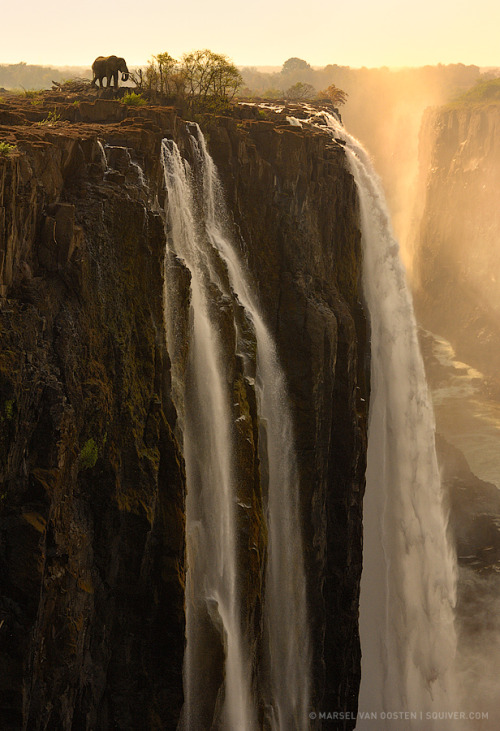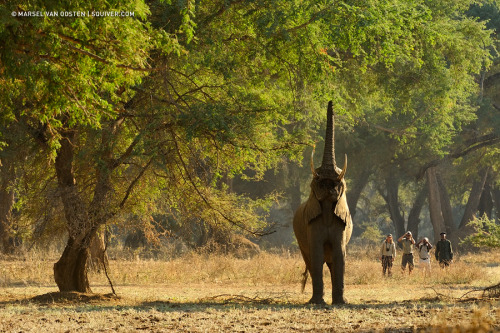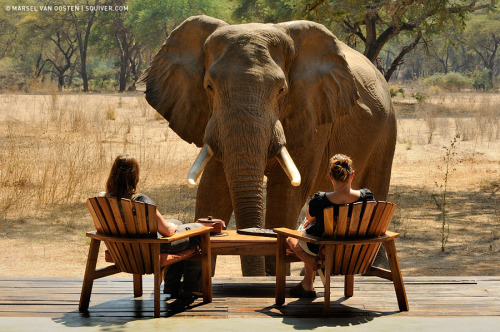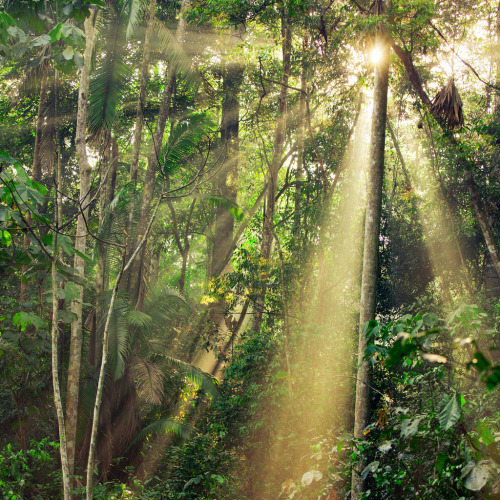
YanisKyr
Shared posts
Winners of the Red Bull Illume Photo Contest 2013
The winners have just been announced in the 3rd edition of the Red Bull Illume Image Quest photo competition. The overall winner, top 10 category winners and top 50 finalists were unveiled at a ceremony in Hong Kong earlier today. The contest invited photographers to submit images of the world of action and adventure sports in one of 10 categories, including Energy, Illumination, Sequence, and Experimental (where digital manipulation is allowed). This year the competition received more than 28,000 entries by 6,417 photographers from 124 countries. Below are some of the winning images, accompanied by the stories behind the shots, in the words of the photographers themselves. (Also, be sure to see the earlier entry, featuring some of the semi-finalists.) [36 photos]


Pic of the Day: Surfer's Perfect Day

For surfers, it's hard to imagine a more perfect day than this. Oahu’s Zak Noyle photographed surfer Christian Redongo casually standing inside a turquoise barrel, while a massive rainbow spans from edge to edge, hitting, one one side, the lush island of Tahiti. With this photo, Noyle won Surfer Magazine's 2011 Photo of the Year contest.
"It was an amazing afternoon with just my friends out in the water," Noyle explains. "There were five guys in the water with pristine conditions. It wasn’t huge, but I saw that rainbow forming. I was shooting fisheye, and I was quite close in, so I kind of kicked back toward the channel and framed it up like that. It was just a quick moment, it only lasted for two waves, and it just happened to be a setup."
Surfer Magazine
via [Reddit]
Animals Dressed In Clothes That Fit Them Like a Second Skin
Madrid-based advertising and industrial photographer Miguel Vallinas presents a fashion photo series, titled Second Skin, where animals are digitally dressed in some super stylish outfits that fit them like a second skin. Miguel photographed over 50 animals, and dressed them up in clothes that seem to be an extension of each of their personalities. The pictures look so natural, they almost make you feel bad about some of your choice of clothes!
Website: miguelvallinas.com














Related posts:
- Dogs Dressed Like Their Owners by Sebastian Magnani
- Wild Animals Taking Over Abandoned House in the Woods
- Miniature Crocheted Animals by Su Ami
Animals Dressed In Clothes That Fit Them Like a Second Skin originally appeared on DeMilked on August 27, 2013.
Survey Results

100% of respondents believe pandas are cuter than koalas (in a survey of pandas).
Incredibly Detailed Pen & Ink Drawings by Tim Jeffs
New Jersey-based illustrator Tim Jeffs is one of those people whom you envy for his great precision and patience. The artist has spent the last year drawing with nothing but ink and pens, and it was his son Harrison that decided to present dad’s drawings to the world. After an overwhelming reaction on reddit, the father and son decided to put the drawings on sale. With each piece taking 12 to 16 hours to complete, Tim’s drawings capture even the smallest details of each animal’s fur, skin texture and patterns. Amazing, aren’t they?
Website: imgur


















Related posts:
- Incredibly Detailed Animal Paper Sculptures by Calvin Nicholls
- Incredibly Detailed Close-Ups of Van Gogh’s Paintings from Google Art Project
- 3D Pencil Drawings That Leap Out Of Page
Incredibly Detailed Pen & Ink Drawings by Tim Jeffs originally appeared on DeMilked on August 26, 2013.
This is how your 'likes' on facebook helps fight hunger and disease
Client: Can you make the black look more white? Me: You mean more of a grey colour? Client: No, I...
Client: Can you make the black look more white?
Me: You mean more of a grey colour?
Client: No, I want the black to look more white.
Wild Animals Taking Over Abandoned House in the Woods
In his House in The Woods photo series, Finnish photographer Kai Fagerström captures wild animals taking over an abandoned house in the woods of Finland.
Six cottages were left to decay after their owner died in the fire, but the building didn’t stay empty for long: “Deserted buildings are so full of contradictions,” says Kai. “I am fascinated by the way nature reclaims spaces that were, essentially, only ever on loan to humans.” Waiting for the animals to show up at a right place is sometimes a lengthy process, but, as Kai says, “The journey is more important than the destination.“
Website: kafa.fi (via: boredpanda)




















Related posts:
- Tippi of Africa: Girl Who Grew Up With Wild Animals
- Miniature Crocheted Animals by Su Ami
- Hyper-Realistic 3D Paintings of Sea Animals by Keng Lye
Wild Animals Taking Over Abandoned House in the Woods originally appeared on DeMilked on August 23, 2013.
59 national drinks from 59 countries

Photo: alextorrenegra
1. Singani (Bolivia)
Singani is produced from white muscatel grapes grown at elevations of 5,250 feet or higher. Rather than age, the quality of the product is determined by the quality of the grapes at the start of production.
2. Soju (Korea)
Soju has a taste comparable to vodka yet slightly sweeter. “In 2006, it was estimated that the average adult Korean (older than 20) had consumed 90 bottles of soju during that year.”[1]
3. Cachaca (Brazil)
Cachaca, or Brazilian rum, has over four centuries’ worth of nicknames coined by its various consumers. This list of over 2,000 terms includes: “abre-coração (heart-opener), água-benta (holy water), bafo-de-tigre (tiger breath), and limpa-olho (eye-wash).”[2]
4. Whisky (Scotland)
“Scotch whisky is always spelled without an “e” (as is whisky from Canada and Japan). Most other nations such as the United States, Australia, and Ireland call their similar spirits whiskey. There are lots of theories as to why this is the case, most of which are disputed. Just be sure you never add the “e” when writing to a Scotsman or you may be the cause of the beginning of World War III.”[3] Scotch whisky is also differentiated by the fact that it’s aged in oak barrels for a minimum of three years.
5. Bourbon (USA)
Bourbon is made with corn and obtains its distinct flavor as it’s aged in barrels. America embraced bourbon to the highest extent, declaring it the “National Spirit of America” in 1964.
6. Pisco (Peru)
Its “smooth and almost non-alcoholic flavor”[4] deceives many first-time drinkers, who quickly become inebriated without noticing. Some people consider mixing pure Pisco with anything else to be a sin.
7. Caesar (Canada)
Spaghetti alle vongole, or spaghetti with tomato sauce and clams, served as Walter Chell’s inspiration for the Caesar, taking this classic from Venice, Italy all across Canada. The Caesar is made with vodka, clamato (clam juice) hot sauce, celery, and lime.

Photo: mariachily
8. Maotai (China)
Maotai, or moutai, is pricey and has a very strong, potent taste. It’s “classified as ‘sauce-fragranced’ because it offers an exceptionally pure, mild, and mellow soy sauce-like fragrance that lingers after it is consumed.”[13]
9. Tequila (Mexico)
A popular “tequila worm” myth rumors that worms can be found in bottles of tequila. This belief stems from certain mezcals typically sold in Oaxaca “con gusano” or “with worm”[6] that actually contain a larval form of a moth that lives on the agave plant tequila is distilled from. In reality, finding one on a plant during production reflects an infestation and a lower-end product.
10. Mojito (Cuba)
The mojito is made from rum, sugar, lime juice, sparkling water, and mint. This refreshing cocktail with growing worldwide popularity “is one of the most famous rum-based highballs”,[7] and is also known as being Ernest Hemmingway’s favorite drink.
11. Guinness (Ireland)
Ireland brews this dry stout in a brewery right in Dublin. “Studies claim that Guinness can be beneficial to the heart. Researchers found that ‘antioxidant compounds’ in the Guinness, similar to those found in certain fruits and vegetables, are responsible for health benefits because they slow down the deposit of harmful cholesterol on the artery walls.”[8]
12. Becherovka (Czech Republic)
“It tastes like Christmas”[9] is the common reaction after someone takes a first sip of Becherovka. Its distinct flavor comes from a combination of anise, cinnamon, and a mixture of herbs.
13. Nsafufuo (Ghana)
Nsafufuo is palm wine made from the sap of palm trees. It’s also known as “kallu” or “toddy,” and is similar to “tuba” found in the Philippines (described below). This palm wine can be served either sweet or sour depending on its preparation.
14. Nihonshu (Japan)
Although it’s commonly known in many places as sake, sake actually refers to any alcoholic beverage in Japan. Nihonshu is fermented rice, sometimes called rice wine, that can be served hot or cold. It is the “oldest spirit in the world.”[10]
15. Mama Juana (Dominican Republic)
Mama Juana is a mixture of rum, red wine, honey, tree bark, and herbs soaked in a bottle. This concoction has “reported positive effects on health, ranging from a flu remedy, to a digestion and circulation aid, blood cleanser, and kidney and liver tonic.”[11]
16. Schnapps (Austria)
The word Schnapps itself comes from the German word for “swallow.” In Germany and Austria, “Schnaps” refers to any strong alcoholic drink, but it’s commonly known as being a fruit-flavored spirit.
17. Brennivín (Iceland)
Brennivín is Iceland’s version of gin. It’s also known as “black death” and means “burning wine” when translated into English, but this drink flavored with caraway, cumin, and angelica is widely popular across Iceland, making it its “signature distilled beverage.”[12]
18. Waragi (Uganda)
Waragi is comparable to gin, with a subtle flavor that’s easily overpowered when used in mixed drinks. The production of waragi is largely unregulated, causing an incident in 2010 in which 80 people died due to high levels of methanol.
19. Jinmen gaoliang (Taiwan)
Jinmen gaoliang is made from fermented sorghum in Taiwan. This white liquor’s distinctly smooth, sweet flavor works well in drinks, as the flavor remains prominent even when mixed.
20. Slivovitz (Serbia)
“Slivovitz is the national drink of Serbia and plum is the national fruit. Plum and its products are of great importance to Serbs and part of numerous customs … A saying goes that the best place to build a house is where a plum tree grows.”[5]
21. Rakı (Turkey)
Rakı is an anise-flavored drink, traditionally consumed straight or chilled with ice or diluted with a small amount of cold water. This twice-distilled grape pomace is similar to pastis or ouzo (both below), as it’s consumed with a variety of hot and cold appetizers.
22. Sangria (Spain)
Named after the Spanish word for blood, “sangre,” for its distinct deep red color. Sangria is typically made with cut fruits including apples, oranges, lemons, and berries mixed with red wine, although white wine can also be used. The fruit sweetens the wine and absorbs it as well. Sometimes orange juice, sugar, honey, or brandy is added to the sangria as a sweetener.

Photo: neurmadic aesthetic
23. Kumis (Mongolia)
Kumis is unique in the respect that it’s a fermented alcoholic drink distilled from a dairy product, rather than a grain or fruit. Kumis is traditionally made from mare’s milk, although due to limited availability, production is now typically done with cow’s milk.
24. Pitorro (Puerto Rico)
“Also known as ron caña (cane rum), this is your basic illegal distilled moonshine, made from sugarcane. Straight pitorro is just as strong as any other moonshine you may have tasted, with alcohol levels into the 120 proof or more. Since it is illegal, the only way to get your hands on some is to have local friends track it down.”[15]
25. Chibuku (Zimbabwe)
Zimbabwe’s homebrew is a combination of water, sorghum, yeast, and enzymes that makes for the chunky, strong liquid known as Chibuku.
26. Chapalo (Niger)
Chapalo is a handcrafted millet beer found in Niger. In local bars, or cabarets, chapalo is brewed in large black caldrons and served in calabash bowls.
27. Arak (Jordan)
“The word arak comes from the Arabic word ‘araq,’ meaning “sweat.”[16] Arak is produced with grapes cultivated in the Mediterranean. The grapes are crushed and put into barrels with juice where they are left to ferment for three weeks. The end product is a milky white and is very similar to rakı in Turkey, or ouzo in Greece.
28. Grappa (Italy)
Grappa is a “fragrant grape based pomace brandy;” it’s strong, ranging from 70-120 proof, so it’s served in small, ornate flute glasses. One of several ways to taste grappa is “by rubbing a small amount on the back of the hand and sniffing. If the aroma is pleasant, the grappa is well made.”[14]
29. Ouzo (Greece)
Ouzo is exclusively Greek. “Clear and silky, with a distinct licorice flavor,” it’s looked down upon to mix ouzo with anything. However, caution is advised due to its high alcohol and sugar levels that will cause the alcohol to have a delayed release into your system. Don’t forget the customary toast that accompanies this national drink: “Stin uyeia sou”, or “To your health!”[17]
30. Arak (Bali)
Not to be confused with arak found in Jordan, arak from Bali is made from distilled coconut palm sap, or from a mixture of coconut milk and black sticky rice. It’s incredibly cheap and is sold in plastic bags. There has been a lot of controversy over arak after several people died from methanol poisoning, but it came from one batch that was unregulated and produced legally.
31. Sombai (Cambodia)
Sombai, or rice wine, is incredibly popular in Cambodia. When used in medicinal cases the taste is bitter, but when infused and distilled properly sombai can be very delicious. It’s infused with fruits and spices and is bottled with a sugarcane stick in bottles each decorated and painted by hand. Eventually, each is crowned and “proudly bears its traditional colourful krama over the bottle top.”[18]
32. Sang som rum (Thailand)
Sugarcane-distilled rum from Thailand, sang som rum “makes you fall on your head,” according to Matador staff writer Katie Scott Aiton. Although it’s virtually unheard of outside of Thailand, it has won gold medal competitions in Madrid and Dusseldorf.
33. Gin (England)
Gin is distilled from juniper berries and enjoyed worldwide due to its versatility as well as the popularity of the martini. Aside from martinis, “there are more classic cocktails made with gin than with any other spirit.”[19]

Photo: Rodrigo Galindez
34. Fernet (Argentina)
Described as having a smell “like black licorice-flavored Listerine,” fernet is a “bitter aromatic spirit”[20] typically served as a digestif, but sometimes with coffee or Coke. Fernet is made with a variety of herbs and spices including myrrh, rhubarb, chamomile, cardamom, aloe, and most importantly saffron, giving it its distinct flavor.
35. Kilimanjaro Lager (Tanzania)
With a picture of Mount Kilimanjaro plastered on each label, Kilimanjaro Lager is a local favorite with its golden color and crisp, mild flavor.
36. Rakshi (Nepal)
This clear, strong drink made from kodo millet or rice has a taste similar to Japanese sake. It typically doesn’t require time to age like many other spirits.
37. Rum (Jamaica)
Rum is produced in pot stills, and its color varies drastically from dark to light. It’s commonly used for blending, rarely drunk neat.
38. Singapore sling (Singapore)
Originally called the gin sling, the Singapore sling was created at the Raffles Hotel in Singapore. It’s composed of gin, cherry brandy, Cointreau, Benedictine, grenadine, pineapple and lemon juice, and angostura bitters, which all contribute to its tropical flavor.
39. Vodka (Russia)
Vodka is often drunk neat but is used in a variety of cocktails such as the Screwdriver, vodka tonic, and Bloody Mary. It’s typically 80 proof and made from fermented grains or potatoes. Today vodka makes up 70% of all alcohol consumed in Russia.
40. Koskenkorva Viina (Finland)
This alcohol is produced with a 200-step continuous distillation process. The result is high-purity industrial ethanol that is then diluted with spring water and a little sugar. Koskenkorva Viina is like Finland’s vodka, also commonly known as kossu.
41. Port wine (Portugal)
Port is a sweet red wine, typically used as a dessert wine. It’s made from grapes from the Douro Valley in northern Portugal.
42. Canelazo (Equador)
Served hot, canelazo is sugarcane alcohol (aguardiente), sugar, and water boiled with cinnamon. Canelazo is made traditionally with homemade aguardiente, but bottled aguardiente can also be used.
43. Tej (Ethiopia)
Tej is mead or honey wine, flavored with powdered leaves and gesho twigs. It has a light, sweet flavor.
44. Jenever (Belgium)
Jenever is a strong juniper-flavored liquor. There are two distinct types of jenever, “oude” (old) and “jonge” (young). Jonge jenever has a taste similar to vodka, “with a slight aroma of juniper and malt wine,” whereas oude jenever “has a smoother, very aromatic taste with malty flavors”[21] due to the fact that it’s sometimes aged in wood.
45. Guaro (Costa Rica)
Guaro is sweet liquor made from sugarcane and is clear in color. It’s considered ‘soft’ vodka due to its lower alcohol content.
46. Unicum (Hungary)
Unicum is an herbal digestif liqueur aged in oak casts, with an ingredient list of over 40 herbs. Traditional unicum is no longer sold in the United States. Instead, a sweeter version can be found under the name “zwack.”

Photo: James Mulholland
47. Pastis (France)
Pastis is an anise-flavored liqueur and aperitif. It’s very similar to raki and ouzo from Turkey and Greece, respectively.
48. Horilka (Ukraine)
This Ukrainian vodka is usually distilled from wheat. Although there are different flavors and derivations, most are homemade.
49. Tuba (Phillipines)
Palm wine, commonly referred to as “kallu” or “toddy,” is called tuba in the Philippines. The name “refers both to the freshly harvested sweetish sap and the one with the red lauan-tree tan bark.” Tuba is made from palm tree sap from trees such as palmyras, date palms, and coconut palms, and has a taste described “somewhere between whisky and rum”.[22]
50. Akevitt (Norway)
Referred to as “water of life,”[23] Akevitt is made from potatoes, along with various spices and herbs. Although caraway is the most popular herb used, anise, cardamom, cumin, dill, and fennel can also make an appearance. Akevitt’s color can range from light to dark brown depending on how long it has been aged in its oak case.
51. Riga Black Balsam (Latvia)
Riga Black Balsam is Latvia’s specific type of balsam, an herbal liqueur. It’s made from natural ingredients and pure vodka. Although it has high alcohol content at 90 proof, it has a bitter yet sweet flavor.
52. Rhum Barbancourt (Haiti)
One of the finest rums in the world, Rhum Barbancourt is exclusively produced and bottled by the Societe de Rhum Barbancourt, making it one of Haiti’s most famous exports.
53. Vana Tallinn (Estonia)
This rum based liqueur has a full-bodied flavor. Vana Tallinn is “sweet with a hint of Jamaican rum,”[24] and is flavored with spices such as citrus oil, cinnamon, and vanilla. It can be drunk straight and is also mixed with coffee, resulting in a concoction similar to Irish coffee.
54. Akvavit (Denmark)
Akvavit, also referred to as “snaps” in Denmark, is dry flavored liquor with a strong presence of caraway. One of the best-known kinds is Ålborg, named after a small town in Jutland on Denmark’s northern coast.
55. Seco Herrerano (Panama)
Seco Herrerano is the national alcoholic beverage of Panama made from triple-distilled sugarcane. It’s typically drunk straight, or used as a substitute for vodka or rum in a variety of cocktails. Although are many types, the Seco Herrerano crafted by the Varela family is the most popular and available in comparison to any competing brand.
56. Tuica (Romania)
Tuica is strong alcoholic drink prepared through a complex, specific process. Most people take shots of Tuica, as it’s very strong, with an alcohol content ranging up to 60%. It’s made solely from plums and prepared only from early October to early December due to its sensitivity to temperature. Then the plums are left to ferment for another six to eight weeks.
57. Mastika (Macedonia)
Mastika is “liquor seasoned with mastic, (resin from the mastic tree, a small evergreen tree native to the Mediterranean Region).” It is “used as an aperitif, poured over ice and enjoyed with meze,”[25] a selection of small dishes that can be served at any meal, or at the start of a large-scale meal.
58. Rakia (Croatia)
Rakija, also known as rakia throughout the Balkans, can be made from a variety of distilled fermented fruits including plums, grapes, apricots, peaches, mulberries, apples, pears, figs and cherries. However, in Croatia it is typically made exclusively from grapes, where it retains its status as Croatia’s most popular spirit.
59. Aguardiente (Colombia)
Aguardiente, also called “guaro,” “is an anise-flavored liquor derived from sugarcane” typically drunk straight. Although this beverage can also be found in countries such as Costa Rica, “aguardiente has maintained, since the Spanish era, the status of the most popular alcoholic beverage in the Andean regions of Colombia.”[26]![]()
[2] http://en.wikipedia.org/wiki/Cachaça
[3] http://blog.foodnetwork.com/fn-dish/2013/01/10-facts-about-scotch-whisky/?oc=linkback
[4] http://en.wikipedia.org/wiki/Pisco
[5] https://en.wikipedia.org/wiki/Slivovitz#cite_note-Mennell-2005-383-23
[6] https://en.wikipedia.org/wiki/Tequila#Ways_to_drink
[7] http://en.wikipedia.org/wiki/Mojito
[8] http://en.wikipedia.org/wiki/Guinness
[9] http://matadornetwork.com/nights/a-night-out-in-prague-with-becherovka/
[10] http://headysake.blogspot.com/2012/09/eleven-fun-facts-about-sake.html
[11] http://en.wikipedia.org/wiki/Mama_Juana
[12] http://en.wikipedia.org/wiki/Brenniv%C3%ADn
[13] https://en.wikipedia.org/wiki/Maotai
[14] http://en.wikipedia.org/wiki/Grappa
[15] http://matadornetwork.com/nights/what-to-drink-in-puerto-rico-besides-a-pina-colada/#ygAKtSjExBZT3kw3.99
[16] http://en.wikipedia.org/wiki/Arak_(drink)
[17] http://greekfood.about.com/od/mezethesdrinks/a/Ouzo.htm
[18] http://www.sombai.com/presentation/
[19] http://www.foodrepublic.com/2012/08/23/10-things-you-didnt-know-about-gin
[20] http://en.wikipedia.org/wiki/Fernet
[21] http://en.wikipedia.org/wiki/Jenever
[22] http://en.wikipedia.org/wiki/Palm_wine
[23] http://en.wikipedia.org/wiki/Akvavit
[24] http://en.wikipedia.org/wiki/Vana_Tallinn
[25] http://en.wikipedia.org/wiki/Mastika
[26] http://en.wikipedia.org/wiki/Aguardiente
New footage of the Japanese tsunami
In September 2011, I sat on the edge of my chair, paralysed by the footage pouring into the media of the destruction caused by the Tohoku earthquake and tsunami in Japan. The clip above — a video that only recently emerged — illustrates the disaster as it developed.
- 1:50 – Small wave appears on the surface of the river; note the water level has dramatically reduced and sirens begin to wail.
- 3:20 – The wave picks up force, ripping at the edges of the bank and destroying moored boats.
- 4:10 – The wave hits a small bridge.
- 6:20 – The power of the water picks up very quickly, and you begin to see a lot of debris.
- 7:40 – The person filming has now retreated to higher ground and witnesses the banks of the river burst and water flood a playground where he/she was standing a minute before.
- 8:20 – A bridge disappears.
- 10:55 – Debris, cars, and houses storm past, and the playground is completely flooded.
- 18:55 – The water calms, leaving its wake clearly visible.
-
22:43 – Looks like a scene from Apocalypse Now.

Internet Explorer vs. Murder Rate [Pic]
Portraits of Toddlers Tasting Lemon for the First Time
First experiences are always exciting – too bad we can’t remember how we felt about most of them. Photographers David Wile and April Maciborka created charming photo series, titled Pucker, where they photographed toddlers and their reactions to a first bite of lemon ever. The reactions and expression that a small slice of lemon brought out were priceless! “Lemons can be a great source of entertainment. Especially when you give babies the opportunity to taste [them] for the first time!” say April and David. Do you think yours was similar to any of these?
Website: aprilmaciborka.com, davidwile.com












Related posts:
- Before and After Portraits Show the Effects of Time and Aging
- Creative Dad Takes Imaginative Photos Of His 4-year-old Daughter
- Long Exposure Photos of Golden Waves by David Orias
Portraits of Toddlers Tasting Lemon for the First Time originally appeared on DeMilked on August 16, 2013.
Face/Off Wedding Edition
And then you realize that the facial hair is perfectly complimentary.
Submitted by: Unknown
20 moments you’ll experience in Spain
Lufthansa A380 First Class: Frankfurt – Singapore

Pic: Lufthansa First Class tickets – Frankfurt to Singapore on A380 (Jul 2013)
Back in December 2012, I gave my parents two Lufthansa First Class round trip tickets to Singapore as their Christmas present. They had never been to Asia before, so I promised them I would join as their tour guide. “Two First Class tickets on the A380 to Singapore, that must have been expensive”, I hear you say. At the time of my booking, Lufthansa was charging €15210 for the two tickets. Instead, I used 315.000 Miles & More miles + €930 in taxes & fees. Now, I didn’t really book a ticket for my parents, I booked one for myself and my father as I wanted to use the Miles & More Senator Companion Award benefit. There were only two First Class award seats available on flight LH778 and LH779 in Dec 2012, so I booked my mother in Business Class with the idea that if Lufthansa did not release more First Class seats, I would take the dentist chair and have my parents in First. Fortunately, that wasn’t necessary. Six days before departure Lufthansa released more F Class seats our outbound flight LH778. It was an even closer call for the inbound flight, where I had to call the Singapore Miles & More service center less than 24 hours before departure to get ahold of my third First Class award seat on our return flight LH779. Unfortunately, I had to pay the full 210,000 miles + €465 in taxes & fees for that third First Class award, quite a steep number of award miles compared to other Star Alliance award redemption charts. Our total came to 525,000 miles + €1395 in taxes & fees for three First Class award tickets BRU-FRA-SIN-FRA-BRU with the segments between Brussels and Frankfurt in Lufthansa Business Class.
Pic: Lufthansa First Class Terminal in Frankfurt (Jul 2013)
Pic: At the entrance of the Lufthansa First Class Terminal in FRA (Jul 2013)
Flying First Class with Lufthansa means you can use their famous First Class Terminal in Frankfurt. This terminal is a dedicated building just for Lufthansa First Class passengers, which has its own security, à la carte dining, spacious bathrooms, sleeping rooms, cigar lounge, bar with exclusive liquors and champagnes, etc… All included in your First Class ticket, of course.
Pic: Bathroom at the Lufthansa First Class Terminal in Frankfurt (Jul 2013)
Pic: Panasonic Relaxation Chairs at Lufthansa First Class Terminal (Jul 2013)
Pic: Make you own cocktails bar at Lufthansa First Class Terminal (Jul 2013)
Pic: Villiger Cigars Humidor at Lufthansa First Class Terminal (Jul 2013)
Pic: Lufthansa First Class Porsche Cayenne Chauffeur Service (Jul 2013)
Pic: Lufthansa First Class Terminal Chauffeur Service in Frankfurt (Jul 2013)
There is no need to walk to the gate when you’re flying from the Lufthansa First Class Terminal at Frankfurt Airport. You will be escoreted and driven onto the tarmac in an exclusive car right to your plane! We had the pleasure of enjoying a Mercedes S and Porsche Cayenne ride.
Pic: Lufthansa Airbus A380 ‘Peking’ at Frankfurt Airport (Jul 2013)
Pic: Lufthansa Airbus A380 First Class Cabin – 8 seats out of 526! (Jul 2013)
Pic: My First Class seat 1A on Lufthansa A380 flight LH779 (Jul 2013)
Pic: Pre-departure drink in First Class: Champagne, of course! (Jul 2013)
Pic: Alfred Gratien Cuvée Paradis Brut Champagne (Jul 2013)
Pic: Lufthansa A380 First Class – Caviar Service Cart (Jul 2013)
Pic: Lufthansa First Class – Caviar with the traditional garnishes (Jul 2013)
Pic: Lheraud Cuvee 30 Petite Champagne Cognac at LH First Class (Jul 2013)
Pic: One of the two spacious Lufthansa First Class bathrooms (Jul 2013)
Pic: Full Flat Bed in First Class on Lufthansa A380 to Singapore (Jul 2013)
Pic: Lufthansa First Class beds 1D and 1G with privacy screens up (Jul 2013)
Pic: My Lufthansa A380 First Class bed 1A on flight LH779 from SIN to FRA
Pic: With my parents in Lufthansa First Class on the Airbus A380 (Jul 2013)
DANGER: New, Potentially Deadly Virus Spreading
Submitted by: Unknown








































